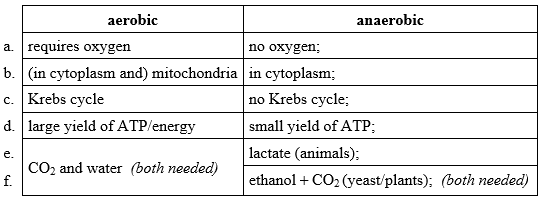Question
a.Describe the genetic code and its relationship to polypeptides and proteins.[5]
b.Outline the role of proteins in active and passive transport of molecules through membranes.[5]
c. Many cell functions, like synthesis of macromolecules and transport, require energy in the form of ATP. Explain how ATP is generated in animal cells.[8]
▶️Answer/Explanation
Markscheme
a.)
Remember, up to TWO “quality of construction” marks per essay.
a. (the genetic code is based on) sets of three nucleotides/triplets of bases called codons;
b. bases include adenine, guanine, cytosine and thymine in DNA / adenine, guanine, cytosine and uracil in RNA; (do not accept ATCG)
c. each codon is code for one amino acid;
d. some codons are (start or) stop codons;
e. DNA is transcribed into mRNA by base-pair matching/complementary base pairing;
f. mRNA is translated into a sequence of amino acids/polypeptide;
g. each gene codes for a polypeptide;
h. polypeptides may be joined/modified to form proteins;
b.)
Remember, up to TWO “quality of construction” marks per essay.
a. channel proteins allow diffusion/osmosis/passive transport;
b. large/polar molecules cannot cross the (hydrophobic) membrane freely;
c. facilitated diffusion involves moving molecules through proteins down their concentration gradient/without requiring ATP;
d. aquaporins (specific integral membrane proteins) facilitate the movement of water molecules/osmosis;
e. some proteins (for facilitated diffusion) are specific to molecule/ions;
f. active transport involves moving molecules through proteins against their concentration gradient/requiring ATP;
g. (some) proteins in the membrane are pumps / pumps perform active transport / sodium potassium pump;
c.)
Remember, up to TWO “quality of construction” marks per essay.
a. ATP is a form of energy currency/immediately available for use;
b. ATP is generated in cells by cell respiration (from organic compounds);
c. aerobic (cell respiration) requires oxygen;
d. anaerobic (cell respiration) does not require oxygen;
e. glycolysis breaks down glucose into pyruvate;
f. glycolysis occurs in cytoplasm;
g. (by glycolysis) a small amount of ATP is released;
h. ADP changes into ATP with the addition of a phosphate group/phosphoric acid / accept as chemical equation;
i. in mitochondria/aerobic respiration produces large amount of ATP / $38 \mathrm{mols}$ (for the cell, per glucose molecule);
j. oxygen/aerobic respiration is required for mitochondrial production of ATP;
k. in mitochondria/aerobic respiration pyruvate is broken down into carbon dioxide and water;
Question
a.State the functions of the following organelles of a eukaryotic animal cell: lysosome, Golgi apparatus, free ribosomes, plasma membrane, rough endoplasmic reticulum.[5]
b. Distinguish between anaerobic and aerobic cell respiration in eukaryotes.[4]
c.Explain the mechanism of ventilation in the lungs in order to promote gas exchange for cell respiration.[9]
lysosome:
▶️Answer/Explanation
Ans:
a.
a. (from Golgi apparatus) with digestive enzymes / break down food/organelles/ cell;
Golgi apparatus:
b. site that processes/modifies/packages and releases proteins;
free ribosomes:
c. site of synthesis of proteins (released to cytoplasm);
plasma membrane:
d. controls entry and exit of materials/substances in cell;
rough endoplasmic reticulum:e. synthesis and transport of proteins; (both needed)
b.)

Award [1] for each contrasting characteristic.
Table format is not necessary for the marks.
c.
a. inspiration/inhalation brings air into lungs;
b. external intercostal muscles contract;
c. and move rib cage upwards and outwards;
d. diaphragm flattens/contracts;
e. increasing thoracic volume;
f. pressure decreases from atmospheric pressure so air rushes into lungs;
g. expiration/exhalation forces air out;
h. internal intercostal muscles contract / external intercostal muscles and diaphragm relax;
i. abdominal/abdomen wall muscles contract and push diaphragm upwards;
j. decreasing thoracic volume;
k. increasing pressure in lungs so air is forced out;
l. a concentration gradient between air sacs and blood needs to be maintained;
Question
a.Explain how materials are moved across membranes of cells by active transport.[2]
b. Explain the effects of pH on enzyme catalysed reactions.[3]
c.Distinguish between the process of anaerobic respiration in yeast and humans.[2]
▶️Answer/Explanation
Markscheme
a.transport against a concentration gradient / from low to high concentration; through protein pumps; uses energy/ATP;
b.enzymes have a pH optimum; active site works best at this $\mathrm{pH}$; activity decreases above and below the optimum; by interfering with $\mathrm{H}$-bonding/active site structure; denaturing by extremes of $\mathrm{pH}$ so enzyme activity/reaction stops;
c. yeast: pyruvate to ethanol and carbon dioxide; humans: pyruvate to lactic acid; Award [1 max] if products are appropriately linked to organisms without the mention of pyruvate.
Question
a.Distinguish between ventilation, gas exchange and cell respiration.[4]
b.Outline the process of aerobic respiration.[6]
c. Respiration and other processes in cells involve enzymes. Explain the factors that can affect enzymes.[8]
▶️Answer/Explanation
Markscheme
a.ventilation is moving air into and out of lungs/inhalation and exhalation;
involves (respiratory) muscle activity;
gas exchange involves movement of carbon dioxide and oxygen;
between alveoli and blood (in capillaries) / between blood (in capillaries) and cells;
cell respiration is the release of energy from organic molecules/glucose;
(aerobic) cell respiration occurs in mitochondria;
To award [4 max] responses must address ventilation, gas exchange and cell respiration.
b. during glycolysis glucose is partially oxidized in the cytoplasm;
(small amount/yield of) ATP produced;
(two) pyruvate formed by glycolysis;
pyruvate absorbed into/broken down in the mitochondrion;
requires oxygen;
carbon dioxide is produced;
water is produced;
large amount/yield of energy/ATP molecules (per glucose molecule);
C. collisions between enzyme/active site and substrate;
enzyme activity increases as temperature rises;
more frequent collisions at higher temperatures;
each enzyme has an optimum temperature / enzymes have optimal temperatures;
high temperatures (above optimum) denature enzymes;
each enzyme has an optimum pH / enzymes have optimal pHs;
increase or decrease from optimum $\mathrm{pH}$ decreases rate of reaction/activity;
extreme $\mathrm{pH}$ alters/denatures the tertiary/3D protein/enzyme structure;
increasing substrate concentration increases the rate of reaction;
higher substrate concentration increases chance of collision;
until plateau;
when all active sites are busy;
Accept clearly annotated graph.